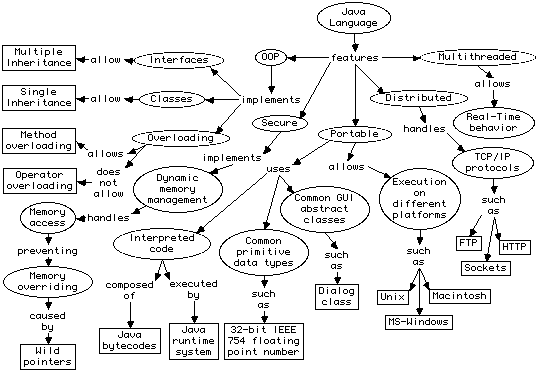
Concept Map of the Java Programming Language (Source: Flores1997)
In this course, we will use a technique called concept mapping for two reasons:
In this document, I'll give a brief explanation of how to do concept mapping, some examples of concept maps, and a list of links to explore if you are still stuck. But first, the best thing to do is probably to just show you an example that relates directly to something you are (hopefully) familiar with already: the Java programming language.
Suppose you to reenforce your understaning of the following concepts about the Java programming language, and show someone that you understand the relationship between these concepts:
Demonstrate your understanding of the following aspects of Java, relating them to specific language features and benefits: (1) object-oriented, (2), secure, (3) portable, (4) multithreaded, and (5) distributed.
You could write a brief essay. However, if you had to do this off the top of your head, it might be difficult to organize your thoughts. In addition, it would be hard for someone, just at a glance, to know whether you really understand, or have just memorized some list from a textbook and are "regurgitating it".
Suppose instead, given only the five "aspects of Java" listed above, you were able to produce the following diagram. Spend some time exploring this diagram in detail before you read on.

Concept Map of the Java Programming Language (Source: Flores1997)
After studying this diagram, hopefully it is clear that:
That is the idea of concept mapping.
Boxes (or circles) containing words that describe a concept
Lines connecting the boxes showing that there is a relationship between the concepts
However, there is a lot of room for creativity. You are encouraged to use whatever visual representations make the concept more clear.
Computer science students (who have taken MATH210) will recognize this structure as a graph with vertices (nodes) and edges. The example map of the Java language shown above happens to take the form of a directed graph, and also happens to be a rooted tree with "Java" as the root node. However, this need not always be the case, as you will see if you explore a variety of concept map examples.
Of course! The following links will take you to dozens of examples.
@@@ INSERT MORE EXAMPLES HERE
If you are assigned to create a concept map, you may be given one of several starting points:
In each case, a six-stage process (from White2001) will lead you through creating a concept map.
Here are the six stages:
Here are details for each step. You can also find these six stages as an online slide presentation. (Click on the image at the right to go to that presentation.)
"From your memory, (which you can jog by going through your notes and related course material) identify facts, terms, and ideas that you think are in anyway associated with the topic. Make a list of these items and print them neatly on small Post-It® notes, one per note, in very brief form, i. e. a single word or short phrase. This is a brain-storming process, so write down everything that anybody in your group thinks is important and avoid discussing how important the item is. Don't worry about redundancy, relative importance, or relationships at this point. Your objective here is to generate the largest possible list you can. Before your group completes this step, you may have more than 50 items."
"Spread out your concepts (Post-It® notes) on a flat surface so that all can be read easily and, together, create groups and sub-groups of related items. Try to group items to emphasize hierarchies. Identify terms that represent those higher categories and add them. Feel free to rearrange items and introduce new items that you omitted initially. Note that some concepts will fall into multiple groupings. This will become important later."
"On a large sheet of paper, try to come up with an arrangement (layout) that best represents your collective understanding of the interrelationships and connections among groupings. Feel free to rearrange things at any time during this phase. Use a consistent hierarchy in which the most important concepts are in the center or at the top. Within sub-grouping, place closely related items near to each other. Think in terms of connecting the items in a simple sentence that shows the relationship between them. Do not expect your layout to be like that of other groups. It may be advisable to meet outside of class to work on this assignment and plan for its completion."
"Use lines with arrows to connect and show the relationship between connected items. Write a word or short phrase by each arrow to specify the relationship. Many arrows can originate or terminate on particularly important concepts."
"Carefully example the draft concept map. Rearrange sections to emphasize organization and appearance. Remove or combine items to simplify (remember that more complex is not necessarily better; the goal is clarity). Consider adding color or different fonts if this will highlight additional relationships or make the map eaiser to read. If you are working in a group, discuss any aspects where your group members opinions differ about the final product."
"After your group has agreed on an arrangement of items that coveys your understanding, you need to convert the concept map into a permanent form that others can view and discuss. Be creative in a constructive way through the use of colors, fonts, shapes, border thickness, etc. to communicate your group's understanding. Give your concept map a title. If you want to construct your final concept map on a computer, try using PowerPoint. In reviewing your concept map, consider the following attributes:
Ok, here are some resources to help you get unstuck.
If you've read through all that and still aren't sure what to do, then come see me during office hours, or make an appointment.